“I see a need for a decision that should have been made a long time ago: to immediately recognize the independence of the People’s Republic of Donetsk and the People’s Republic of Luhansk” – in these words Russian President Vladimir Putin has signed orders declaring these areas in the Donbass region no longer part of Ukraine. Putin’s announcement came hours after separatist leaders released a video in which they sought to declare independence.
In a move that provoked, as expected, NATO countries, Putin ordered troops to enter parts held by separatists in eastern Ukraine as part of what he defined as a “peacekeeping” mission – just hours after signing the Declarations of Independence.
In an enthusiastic speech on Monday evening, the veteran Russian president, who has been more than twenty years since he first came to power, sharply criticized Kiev’s growing security ties with the West, and especially with the United States, and seemed to question Ukraine’s right to self-determination: “In Ukraine there have never been traditions of an independent state,” he said, adding that the eastern parts of the country in which Donetsk and Luhansk are located are “ancient Russian lands.”
In recent years Russia has done almost everything it can to make Donbas a separate country from Ukraine. The political integration of the two pro-Russian enclaves with Russia goes hand in hand with an attempt to make sure that culturally, they will be alienated from the rest of Ukraine.
Geography: Where are these districts located?
The Donetsk and Luhansk regions – which are part of a region known as Donbas – are located in eastern Ukraine, near the border with Russia. The area includes both parts controlled by Kiev and parts controlled by separatists. The areas controlled by the separatists in Donbas became known as the People’s Republic of Luhansk (LPR) and the People’s Republic of Donetsk (DPR).
The Ukrainian government in Kiev has determined that both districts are actually occupied by the Russians. The republics have declared independence, but have so far not been recognized by any government in the world as independent states or autonomies. Over the years, the Ukrainian government has refused to enter into direct talks with them.
Until last night, no country had recognized their ambition. After meeting with his Russian Security Council in the Kremlin at a well-publicized event on Monday, Putin declared the independence of the two provinces. Now, Russia’s allies like Syria and Nicaragua are promising to join Russian recognition.
Each district has a president, who has proclaimed himself a leader. Although Kiev does not recognize their legitimacy, in democratically problematic elections in 2018 Dennis Pushilin was elected to lead the People’s Republic of Donetsk, and Leonid Peschnik leads the separatist region of Luhansk.
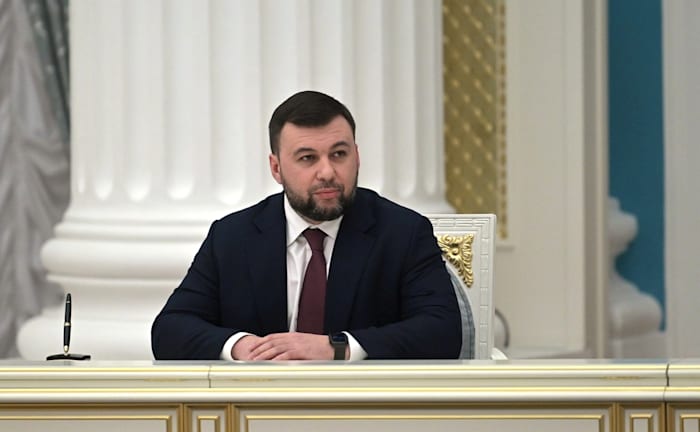
Dennis Pushilin, leader of the Republic of Donetsk / Photo: Reuters, EYEPRESS
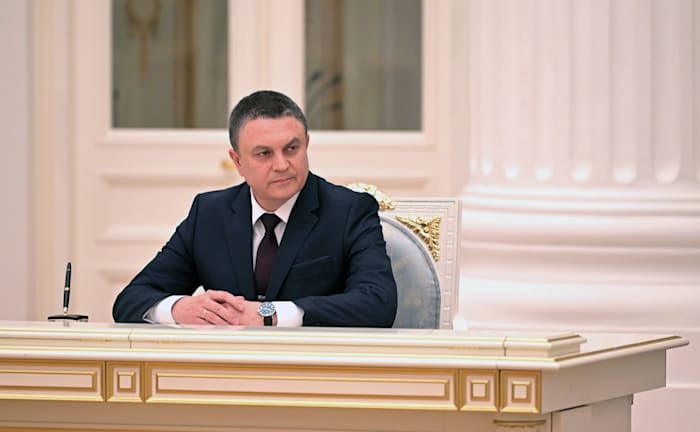
Leonid Paschnik, Leader of the Republic of Luhansk / Photo: Reuters, EYEPRESS
Population composition: Russian workers who immigrated after the Second World War
As a result of the migration of Russian workers after World War II to the territories of Ukraine near the border, most of the 3.6 million inhabitants living in Donetsk and Luhansk are Russian-speaking. Many of them have significant Russian roots.
If at the beginning of the conflict the question of identity was not urgent and many locals felt that it was possible to be both Ukrainian and Russian at the same time, the events of recent years have changed that.
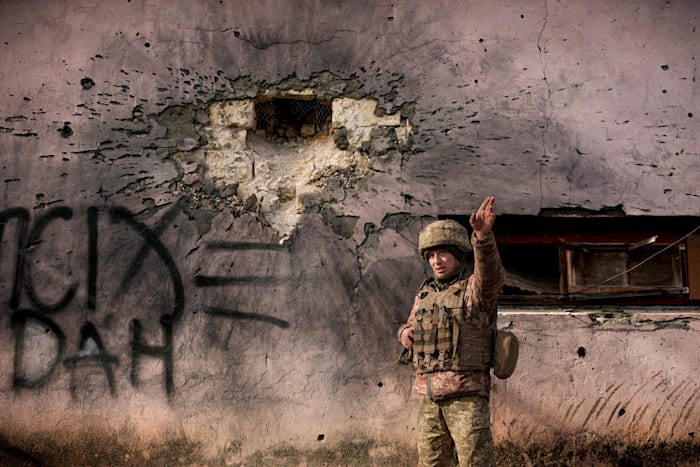
Ukrainian soldier near a building bombed in a village in the Luhansk region, eastern Ukraine, on Saturday / Photo: Associated Press, Vadim Ghirda
History: The Russian Donbass Doctrine
Even after the fall of the Iron Curtain in the late 1980s and the subsequent disintegration of the Soviet Union, Moscow continued to see Ukraine as an important geopolitical space. Therefore, Russian leaders have watched with great and open concern the rise of pro-Western sentiment in Ukraine in recent years.
As of last year, the “Russian Donbass Doctrine” seems to represent the official ideology of these two pro-Russian enclaves.
According to the doctrine, the Donbass region is Russian land, and the countries created after the dissolution of the Soviet Union (in the case of Ukraine: after a vote in which 90% of the population wanted independence) are “artificial” and constitute “anti-Russian” projects. In the last two years Russian flags have begun to replace the flags of the two districts in administrative buildings, streets and squares.
Civil war in Ukraine
In February 2014, pro-Russian President Viktor Yanukovych was ousted in a series of demonstrations that lasted about three months against the president’s decision not to sign a cooperation agreement with the European Union. Jankovic fled to Russia, where he was granted political asylum.
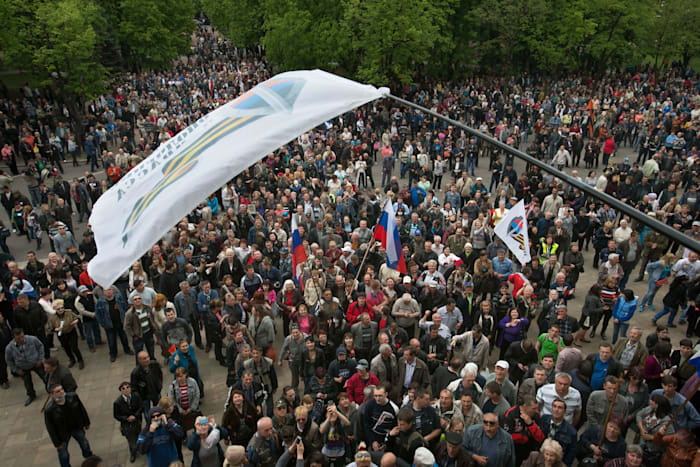
Pro-Russian activists in the Donbas area celebrate in front of the city hall after taking over, 2014 / Photo: Associated Press
The rise to power of pro-Western Ukrainian circles would fuel the desire of some of the population in specific areas of southeastern Ukraine to secede from Ukraine and join Russia or establish an independent state called Novorussia (“New Russia”).
At the end of February 2014, special Russian armed forces and pro-Russian separatists invaded government buildings, military bases and government buildings of Ukraine in the Crimean peninsula. Russia’s takeover of the Crimea has also gained control of the peninsula’s economic waters in the Black Sea and the Moss Sea, where there are large reserves of oil and natural gas.
Following the annexation of Crimea by Russia in March 2014, pro-Russian demonstrations and protests began in southern and eastern Ukraine. These escalated into an armed confrontation between the separatist forces of the People’s Republics of Donetsk and Luhansk and the Ukrainian government. The one who ignited the fire of the “popular uprising” was the Moscow administration.
Revocation of the Minsk Protocol
Russia’s recognition of the de facto region effectively ends the peace talks in Minsk, which have never been fully implemented.
The agreements, aimed at stopping fighting in the Donbas region, were signed in 2014 and 2015 and called for a great degree of autonomy for the two provinces within Ukraine, including a promise of local elections, the withdrawal of armed military forces from the region and the adoption of an economic rehabilitation program for residents.

Pro-Russian separatist tank in post-war Donbas area / Photo: Associated Press, Dmitry Lovetsky
After separatists in the Donetsk and Luhansk regions seized power in 2014, they held a referendum on independence. Since 2014, more than 14,000 people have been killed in fighting in the Donbas region between pro-Russian separatists and Ukrainian military forces, and more than a million people have been displaced. Over the years Ukraine and the West have accused Russia of financial and military support for the rebels – a claim that Moscow has denied.
The agreement was written by representatives from Ukraine, Russia, and the Organization for Security and Cooperation in Europe (OSCE), mediated by representatives from Germany and France. The agreement was signed on September 5, 2014 by representatives of Ukraine, Russia, Donetsk and Luhansk. Another agreement was signed about six months later.
Citizenship: Russia issues passports – then claims it protects its citizens
According to various estimates, the pro-Russian enclaves currently house about 45% – 70% of the population, which was before 2014 – more than four million people at the time. Five years later, in 2019, Putin signed an order giving residents the option of obtaining a Russian passport in a simple procedure.
According to the AP news agency, by January this year, Moscow had issued more than 720,000 Russian passports to about one-fifth of the region’s residents, and more were awaiting a passport. All of these are now officially defined by the Kremlin as “Russian citizens living in the Donbas.”
This move has wide significance for Russia and Ukraine. Now the Kremlin (and it does) can claim that it not only supports Russian-speaking Donbas but de facto protects Russian citizens in every way.
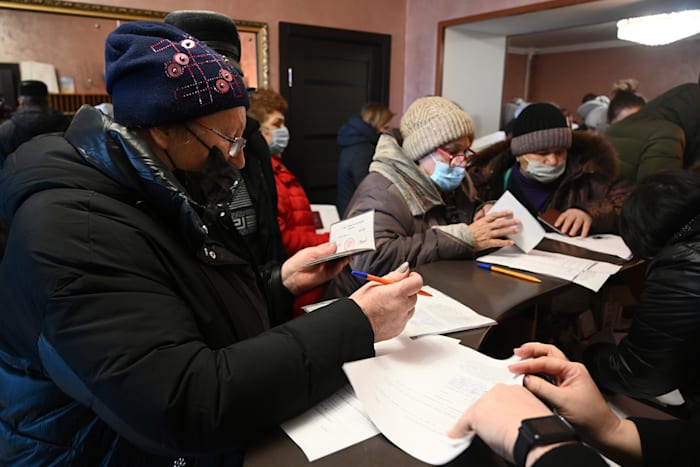
Issuance of passports for Donetsk residents / Photo: Associated Press
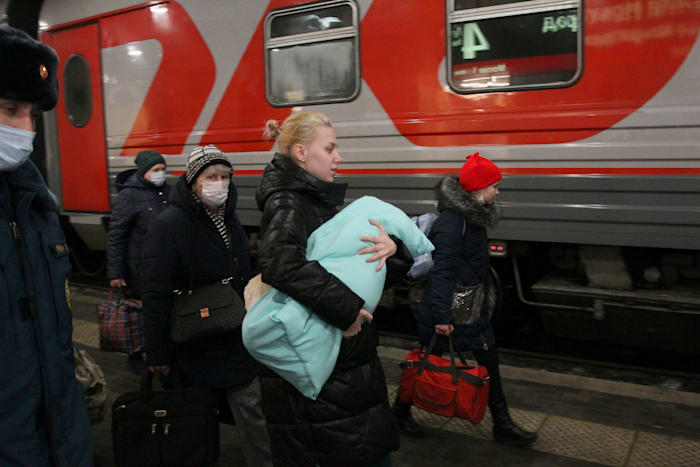
Residents evacuate from Donetsk amid growing tensions in the area / Photo: Associated Press, Roman Yarovitcyn
Another sign of a tightening of Russia’s relations and responsibilities over the enclaves or even just of Russia’s public desire to show that there are some, can be seen in the Duma elections (the lower house of the Russian parliament) held in September. During the election, more polling stations were opened in the Rostov Oblast, located near the Ukrainian border, to allow new Russian citizens to vote.
Social conditions: Approaching Russia and receiving benefits
The connection between Russia and many of the citizens of the pro-Russian territories has many consequences. One of the most important of these, in which Russia’s commitment to its new citizens can be seen, is their right to demand Russian pension and social security payments. This makes it easier for them to find work and a livelihood in Russia as well as to be employed by Russian citizens and businesses.
Thus, while the Russian axis and the bond between Russia and the enclave dwellers tightened to some extent, the bond with Ukraine became increasingly shaky. For example, it has become more difficult for Donbas residents to obtain a Ukrainian identity card, travel west into Ukraine, receive medical treatment from the state or even receive welfare payments from the state.
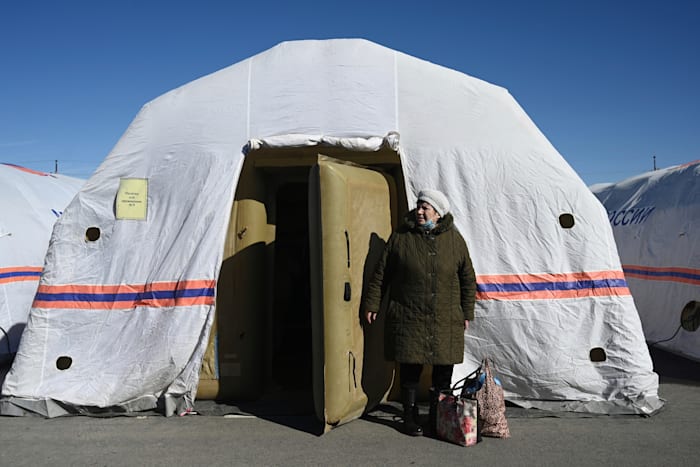
A woman evacuated from Donetsk standing in front of a tent in a refugee camp on the border with Russia / Photo: Associated Press
The two “People’s Republics” removed the status of the Ukrainian language as an official language by 2020. Since then, schools in these areas have stopped teaching Ukrainian and in history classes have stopped teaching the history of Ukraine – a very significant step designed to sever ties. Young people born shortly before or during the crisis grow up without any sense of Ukrainian identity.
Economy: The Kremlin abolished import duties on all goods
The main industries in the two republics are coal mining and steel production. In 2017, Ukraine severed all economic ties with the unrecognized republics: the transfer of goods, electricity and water in both directions was halted.
Since then, Russia has been the sole economic partner of the unrecognized territories, and their budgets also rely heavily on Russian subsidies. In November, an order of the Kremlin abolished the import customs on all goods from these areas to Russia. Last year, all the major factories in the two republics were transferred to a company owned by Russian businessman Yevgeny Yurchenko.
